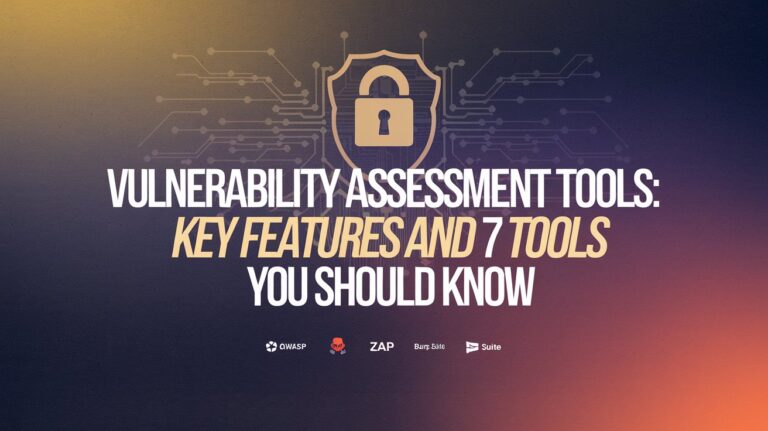Despite the increasing complexity of cyber threats, it is paramount that you encrypt your web application. Potential vulnerabilities that go unfixed could lead to financial loss, reputational harm, and data breaches. You can improve your defenses against possible attackers by doing a comprehensive web vulnerability assessment, which enables you to identify and address issues earlier.
This post will go over the key benefits of vulnerability assessments and offer professional advice on how to improve your security plan so that you have a strong online presence in 2025.
Important Tools for Web Vulnerability Assessment
I’ve given the details of these tools below:
- OWASP ZAP (Zed Attack Proxy)
- Burp Suite
- Nikto
- Nessus
- Acunetix
- Arachni
- OpenVAS
1. OWASP ZAP (Zed Attack Proxy)
OWASP ZAP is a free, open-source tool for identifying vulnerabilities in web applications. Designed for beginners, it supports automated scanning and manual testing. It integrates well with CI/CD pipelines, making it ideal for continuous security testing. Although not as feature-rich as premium tools, it’s excellent for early-stage security assessments and developer-friendly environments.
- Best Point: Comprehensive for testing vulnerabilities during all phases of development.
- Features: Free, user-friendly.
Website: OWASP ZAP
2. Burp Suite
Burp Suite is a robust security testing platform for professionals, offering manual and automated testing. Its free version is suitable for learning, while the Pro version delivers advanced features like vulnerability scanning and plugin extensions. With its vast community and resources, Burp Suite is highly versatile for both beginners and experts but can be costly for advanced functionality.
- Best Point: Offers the most comprehensive scanning and testing for advanced users.
- Features: Paid, professional-grade, most users.
Website: Burp Suite
3. Nikto
Nikto is a lightweight, command-line-based vulnerability scanner focused on identifying outdated software, misconfigurations, and common web server issues. It is fast and simple, making it a go-to for quick checks. However, it lacks modern web application testing features, making it better for traditional setups.
- Best Point: Best for quick, basic vulnerability assessments.
- Features: Free, fast.
Website: Nikto
4. Nessus
Nessus is a highly accurate vulnerability scanner used by enterprises to detect security gaps across various environments. It provides detailed reports and a vast library of plugins for targeted scanning. Though it’s paid-only, Nessus is a top choice for organizations requiring reliability and advanced assessments.
- Best Point: Ideal for enterprise-grade security assessments.
- Features: Paid, enterprise-grade.
Website: Nessus
5. Acunetix
Acunetix is an automated scanner designed for modern web applications. It detects complex vulnerabilities like SQL Injection and XSS with high precision. Its user-friendly interface makes it accessible to beginners, while automation features benefit enterprises. However, its high cost can be a barrier for smaller teams.
- Best Point: Best for automating security testing.
- Features: Paid, user-friendly.
Website: Acunetix
6. Arachni
Arachni is an open-source tool for testing vulnerabilities in modern frameworks and web applications. It supports distributed scanning and automation, making it effective for advanced setups. Although no longer actively maintained, it remains a valuable resource for free vulnerability assessments.
- Best Point: Excellent for modern application frameworks.
- Features: Free.
Website: Arachni
7. OpenVAS
OpenVAS is a comprehensive vulnerability scanner for web and network security. As an open-source tool, it’s cost-effective for enterprises and individuals alike. It excels in large-scale environments but requires more setup and resources than simpler tools.
- Best Point: Best for network-wide scanning alongside web vulnerabilities.
- Features: Free, comprehensive.
Website: OpenVAS
| Tool | Pros | Cons |
|---|---|---|
| OWASP ZAP | Free, beginner-friendly, integrates with CI/CD, supports active/passive scans. | Limited advanced reporting; not ideal for large enterprise use. |
| Burp Suite | Comprehensive scanning, plugin support, robust for professional testing. | Free version is basic; Pro version is expensive. |
| Nikto | Fast, lightweight, detects common server misconfigurations. | Outdated interface; lacks advanced features for modern web apps. |
| Nessus | Enterprise-grade accuracy, detailed reports, vast plugin library. | Paid-only; can be expensive for small teams or individuals. |
| Acunetix | User-friendly, automates scanning, detects modern web vulnerabilities. | High cost; primarily targets enterprise users. |
| Arachni | Free, supports distributed scanning, great for modern frameworks. | No longer actively maintained; setup can be tricky. |
| OpenVAS | Open-source, supports comprehensive scans, ideal for networks too. | Complex configuration; can be resource-intensive. |
Conclusion
Web vulnerability assessment tools are indispensable in today’s digital landscape, ensuring the security of web applications against potential threats. Each tool, from the versatile OWASP ZAP to the enterprise-grade Nessus, serves unique purposes based on specific needs, such as scalability, ease of use, or budget constraints. Selecting the right tool requires balancing features, cost, and expertise, but using these tools effectively can significantly enhance the safety and resilience of your online platforms. By integrating these assessments into your regular security practices, you build a proactive defense system, protecting both your data and reputation.
Stay informed, test regularly, and prioritize security to keep your web presence secure and reliable.

